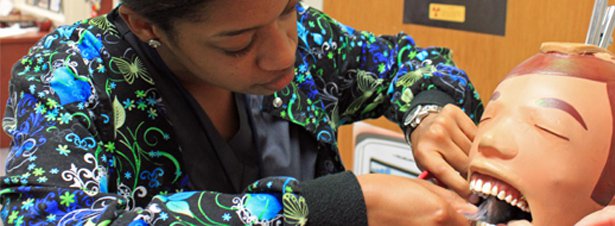
The 2013 graduating class of Orlando Tech’s Dental Assisting program just made history. The students are the first class at the Florida vocational school to use the new digital dental x-ray sensors in the school’s clinical laboratory. In just six months, Orlando Tech took its dental lab to the next level by adding nine new digital intraoral sensors from Sirona, truly making it a state-of-the-art facility that will help prepare students to practice dentistry in the 21st Century.
Need for Change
The 10-month Dental Assisting program, which is accredited by the American Dental Association, has an enrollment of 23 students per semester. Students graduate prepared to take the Dental Assisting National Board CDA exam, learning everything from preventive dentistry and oral pathology to infection control and clinical assisting, in lectures and the hands-on laboratory.
Orlando Tech’s clinical dental lab has a total of seven operatories, each of which has a traditional wall-mounted x-ray unit and darkroom to process the film. Students would each take turns positioning film, taking the image and developing the film. They had previously learned about digital radiography through a nine-week course of lectures and in-class demonstrations.
“Historically, when our students graduate, they walk out with the credentials to work anywhere,” said Cindy Bradley, program director since 1998. “Until recently, the only thing they were missing was real hands-on experience with digital radiography.”
To ensure graduates are prepared to thrive in any dental office today, Orlando Tech needed to keep pace with the growing use of digital imaging in dentistry. This year, Bradley was encouraged by school leadership to transform the Dental Assisting lab by making it digital. In order to stay competitive and attract students in its market, Orlando Tech needed to ensure its technology reflects what is actually being used in practice.
“Everybody I had talked to in the field said they preferred Schick sensors,” said Bradley. “I knew after meeting with school administrators who I needed to call next.”
Going Digital
It was a Friday afternoon in January when Bradley reached out to Mary Ann Rupertus, Professional Clinical Associate at Sirona Dental. By Monday, the Sirona team was on campus to demonstrate the Schick line of intraoral sensors. Rupertus presented to administrators and students on the numerous benefits of digital radiography. The team set up the radiology lab with dummies to take live radiographs, with Rupertus alongside giving placement tips.
“Students picked it up right away. They had already placed dental film in their lab, so when they got to use the Schick sensors, they were enthusiastic about the speed and efficiency,” Rupertus said. “What I find when I go to schools is that the younger students are used to the instant gratification of today’s technology. They don’t want to have to wait for film to be processed; they want information immediately. They recognize the benefits from patient comfort, acceptance and understanding perspectives.”
Orlando Techs placed an order later that week. Today, the Dental Assisting lab’s seven operatories are equipped with nine Schick Elite digital intraoral sensors. Now Bradley and other instructors are able to teach students both digital radiography — along with how to use image management software — and traditional film x-rays.
They chose the Schick Elite for numerous reasons: it comes in multiple sizes to fit patients of all ages; has interchangeable cables for easy movement between classrooms/operatories; and has WiFi and USB connectivity. It also integrates easily with the Schick AimRight Positioning Systems, which helps ensure precise imaging.
Raising Orlando Tech’s Profile
The Dental Assisting program is reaping the benefits of digital from numerous perspectives: time, money and staying ahead of the curve.
“So many offices today are going digital, and I hear feedback from doctors on a daily basis that there is a need for students to understand and know how to use digital,” Bradley said. “With the new Schick digital sensors, I’m confident we’re giving students a state-of-the-art clinical experience and best preparing them for their careers in the dental field.”
Taking film x-rays is a time-intensive process that can take up to 40 minutes — from the time a student seats a patient, takes the images, processes them and then mounts them. Now, with the Schick sensors, time is cut down to several minutes, significantly reducing time wasted in the classroom. With no messy processing or mounting required, students are able to be even more efficient.
As a public school, Orlando Tech simply did not have the budget to buy the sensors. Funding was made possible through a grant secured by Bradley and Sirona’s Education + Training Initiative, which is Sirona’s ongoing investment in education program. The school district supplied laptops and Patterson Dental supplied the Image Management suite for the lab.
Orlando Tech will reap the cost benefits of the technology long term. The Schick sensors will remove the constant cost of film and chemicals, as well as the cost to remove the waste, and pay themselves off quickly.
“If a school is providing students with hands-on experience with only film x-rays, they’re not preparing them for what’s out there in the real world,” said Rupertus. “It’s an investment, but there are big returns to be gained.”
Share with your colleagues